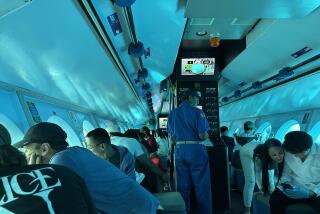It’s the Super Bowl with a science bent
- Share via
SAN DIEGO — It was time for the robotics squad from the University of Maryland to put Tortuga through its underwater paces.
“We need to put a diagnostic on the board so we know the pressure at the surface,” said Stepan Moskovchenko, 20.
Joseph Gland, 24, questioned the way the craft was descending in the practice pool.
“That’s not the desired angle; that’s a weird, secondary, shadowed angle,” he said.
“It’s trying to yaw a lot,” warned Joseph Lisee, 21, as he monitored readings on a laptop.
And so it went in warm-ups for the Super Bowl of underwater robotics: the 10th annual Autonomous Underwater Vehicle Student Competition, sponsored by the Office of Naval Research and co-hosted with the Assn. for Unmanned Vehicle Systems International, a trade group of manufacturers.
The competition ends today. At stake is a $20,000 prize and serious bragging rights wherever students of robotics assemble.
This is the sixth summer that the competition has been held at the Space and Naval Warfare Systems Center on Point Loma, overlooking the Pacific Ocean. The center has a gigantic, soundproof pool that is 200 feet by 100 feet, can hold 6 million gallons of water and is 38 feet at its deepest.
Robotics clubs work on their prototypes all year. But as the San Diego event approaches, they get into a frenzy, rushing to find the right buoyancy, the right hardware, the right software -- the right everything, not too heavy, not too light.
“The last few weeks, we’ve not been doing much sleeping, maybe two or three hours a night. There’s lots to do,” said Tom Feeney, 22, of the University of Florida, which has won the last two years. The name of his team’s craft is a play on the university mascot: SubjuGator.
Each craft must navigate the pool by itself, touch certain buoys, drop markers and surface in a specified recovery zone. Time and proficiency are important.
Competitors are not allowed to use remote controls. The smallest craft is the size of a loaf of bread. The largest is several feet in length and weighs maybe 60 pounds.
Although MIT won five of seven competitions from 1998 to 2004, the school has downplayed its chances this year. Some competitors think MIT is just trying to lower expectations for its Orca-X.
“In some ways it’s like we’re preparing for next year,” said Samuel Kenyon, 25, a graduate student at MIT. “We have a lot of new stuff; lots of things have failed or blown up.”
With 28 schools and about 200 students involved, this year’s competition is the biggest to date. Most schools are from the U.S., but India, Japan and Canada are also represented.
Some competitors have tried to study past winners. Others have decided to use the trial-and-error method of innovation. Some have corporate sponsors; some held fundraisers.
“Everything we’ve done ourselves, nothing from the market,” said Ravinder Singh, 20, leader of the team from Delhi College of Engineering in New Delhi.
Although most of the teams are from big universities, some do not fit the mold. The Pacific Nautilus team from San Diego City College sees itself as David prepping for battle with Goliaths like MIT, the U.S. Naval Academy, Georgia Institute of Technology and USC.
“We’re the underdogs. We’ve been scraping together our nickels and dimes,” said Julian Valdez, 29, president of the school’s robotics engineering club. “Most of us are going to transfer to these big colleges. We want to show them we’re already on their level.”
And then there’s the SMurphs Pair -- Daniel Murphy, 16, and his sister Chandra, 15, two San Diego teenagers who are being home-schooled. Their father is Steven Murphy, a scientist at the Point Loma center.
Exactly what their father does for the center is unclear, even to his family.
“It’s classified,” Chandra said.
Dad has passed on his scientific know-how, though. “He’s made a point of teaching me stuff,” Daniel said as he applied some touches to their craft, called SeeKer.
But however much preparation is done in advance, there is always the unexpected.
“Last year we had issues of flooding due to connectors,” said Alex Stewart, 21, of North Carolina State University. “Now we have new connectors and we have different issues.”
The trick is to program tiny computers to feel the bottom of the pool -- to navigate independently.
“Our hardware is just standard, but we’ve got a software advantage,” said Josh Dian, 22, of the University of Toronto, as he sang the praises of Tortoise 2.5.
“We’re very modular,” he said. “We can very easily pop in more cards and expand our embedded electronics.”
Representatives of firms that do unmanned vehicle work -- including Boeing Co., Northrop Grumman Corp. and Lockheed Martin Corp. -- have been present at the three-day event to look at the underwater craft and, more important, to meet the students.
“These kids are ripe for the recruiting,” said Daryl Davidson, executive director of the Assn. for Unmanned Vehicle Systems International, based in Arlington, Va.
The Navy is also on the recruiting prowl. Ten students from past competitions -- mostly from Duke and Cornell universities -- are now working as Navy researchers.
When crafts enter the big pool, the competitors can only watch through tiny cameras and hope for the best. Two practice pools have been in heavy use.
“OK, before giving it the stamp of approval, let’s do depth control,” Gland said as Tortuga moved slowly beneath the surface. “Rotational and speed,” he added.
The University of Maryland team members nodded. Of course.






